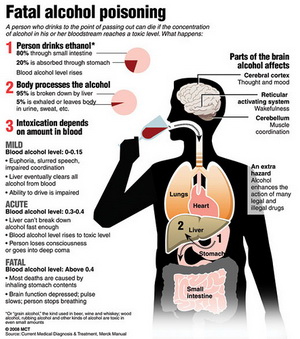|
Alcohol Metabolism – Neutralizing The Effects Of A Toxic SubstanceAlcohol metabolism begins quickly after ingesting alcohol, with absorption in the mouth and esophagus where it enters the blood stream in small amounts. Absorption then continues in the stomach, but the small intestine absorbs the majority of alcohol.
When alcohol metabolism is successful alcohol travels to the portal vein of the liver where the most metabolisms take place. Metabolism achieves two goals; one is to produce energy and another to protect the body from the toxic effects of alcohol metabolism which creates the byproduct acetaldehyde. Because the body can’t store this potentially toxic substance it works hard to get rid of it. If alcohol is allowed to accumulate in the body destruction of the body’s cells and organs can occur so the body metabolizes it quickly and removes it from the blood. There is a zinc containing enzyme alcohol dehydrogenase (ADH) that will convert small amounts of alcohol to the toxic substance acetaldehyde. Since this substance is toxic, build-up must be avoided and this is done through another enzyme acetaldehyde dehydrogenase which converts acetaldehyde to acetate. Since not all acetaldehyde is converted to acetate the body’s priority is to get rid of this substance that is more toxic than alcohol and which can destroy the lining of the gut. The body’s alcohol metabolism takes precedence over the breakdown of carbohydrates, fats, and proteins; this emphasizes the seriousness of getting rid of such a toxic substance. Once in the liver alcohol is detoxified by the liver cells where alcohol is broken down and used in fatty acid synthesize, that are then transformed into fats, which can be seen in the liver of alcoholics and fatty liver is the first stage of liver destruction in alcoholics. Alcohol Poisoning When excessive alcohol is consumed the brain is deprived of oxygen. Eventually due to oxygen deprivation and the brain’s struggle to deal with an alcohol overdose, the brain shuts down the functions that regulate breathing and heart rate and the individual slips into a coma and can die, even if death does not occur, irreversible brain damage can occur. Differences In Alcohol Metabolism Men and women have different responses to alcohol. For women blood alcohol level rises faster, thus women become intoxicated quicker than men with an equivalent dose. In addition, women metabolize alcohol at a slower rate than men. There are also other factors that account for the greater effect that alcohol has on women and these are: • Body size – since women are smaller on average than men with smaller livers and less total water. • Body composition - women have less water to dilute alcohol since they have a higher percentage of fat than men. • Less enzyme activity – alcohol dehydrogenase, the primary enzyme involved in the metabolism of alcohol, is up to 40% less active in women than men.
• Chronic alcohol abuse – women have a lower capacity for alcohol than men and alcoholism exerts a greater toll on women than men, with female alcoholics having a death rate 50-100% higher than male alcoholics. In addition, a higher percentage of female alcoholics die from suicides, alcohol-related accidents, circulatory disorders, and cirrhosis of the liver. • Hormonal fluctuations – women typically have a higher response to alcohol which is increased when they are about to have their periods or when taking birth control pills. Not only are there gender differences between individuals but between ethnic groups and age groups as well, as a result individuals differ in their susceptibility to intoxication, hangover, and long term addiction and organ damage.
Next: For other information on nutrition some great references are: • Nutrition – Fourth Edition by Paul Insel, Don Ross, Kimberley McMahon, and Melissa Bernstein
Alcohol and Diet
|






